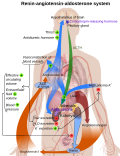Search results
Appearance
There is a page named "Enalapril" on Wikipedia
- Enalapril, sold under the brand name Vasotec among others, is an ACE inhibitor medication used to treat high blood pressure, diabetic kidney disease,...19 KB (1,686 words) - 16:49, 7 February 2024
- profile in trials of sacubitril/valsartan compared to valsartan alone or enalapril [an angiotensin converting enzyme inhibitor] is very similar, with the...37 KB (3,449 words) - 20:05, 31 May 2024
- include benazepril, zofenopril, perindopril, trandolapril, captopril, enalapril, lisinopril, and ramipril. ACE inhibitors were initially approved for...64 KB (7,001 words) - 10:33, 27 June 2024
- jararaca). Enalapril is a derivative, designed by scientists at Merck to overcome the rash and bad taste caused by captopril.: 12–13 Enalapril is actually...22 KB (1,851 words) - 03:49, 1 June 2024
- Enalaprilat is the active metabolite of enalapril. It is the first dicarboxylate-containing ACE inhibitor and was developed partly to overcome these limitations...5 KB (332 words) - 05:24, 30 January 2024
- Enalapril/hydrochlorothiazide, sold under the brand name Vaseretic among others, is a fixed-dose combination medication used for the treatment of hypertension...5 KB (160 words) - 02:17, 5 November 2023
- common ACE Inhibitors are: Benazepril (Lotensin) Captopril (Capoten) Enalapril (Vasotec) Lisinopril (Prinivil, Zestril) Ramipril (Altace) Some common...3 KB (287 words) - 05:50, 31 October 2023
- C09BB02 Enalapril and lercanidipine C09BB03 Lisinopril and amlodipine C09BB04 Perindopril and amlodipine C09BB05 Ramipril and felodipine C09BB06 Enalapril and...4 KB (470 words) - 15:39, 25 January 2024
- II receptor antagonists, eprosartan is generally better tolerated than enalapril (an ACE inhibitor), especially among the elderly. The compound came into...5 KB (166 words) - 19:27, 20 December 2023
- AR, et al. (September 2014). "Angiotensin-neprilysin inhibition versus enalapril in heart failure". The New England Journal of Medicine. 371 (11): 993–1004...7 KB (526 words) - 15:48, 25 March 2024
- Lidocaine Verapamil Complementary: Amiodaroneα Amlodipine Bisoprolol Enalapril Hydralazine Hydrochlorothiazide Lisinopril/amlodipine (lisinopril + amlodipine)...67 KB (4,835 words) - 05:45, 16 May 2024
- inhibitors – e.g. Prinzide or Zestoretic (with lisinopril), Co-Renitec (with enalapril), Capozide (with captopril), Accuretic (with quinapril), Monopril HCT...25 KB (2,187 words) - 19:29, 28 March 2024
- 2005). "Incidence and characteristics of angioedema associated with enalapril". Archives of Internal Medicine. 165 (14): 1637–42. doi:10.1001/archinte...26 KB (2,973 words) - 06:28, 12 April 2024
- first line treatment for some patients. Enalapril/hydrochlorothiazide (trade name Enalapril comp), wherein enalapril is the ACE inhibitor and hydrochlorothiazide...6 KB (275 words) - 22:42, 11 November 2023
- of heart failure. The study was double blinded; compared LCZ696 versus enalapril in patients with heart failure. The study showed lower all cause mortality...32 KB (3,844 words) - 02:19, 4 June 2024
- "Efficacy and safety of lercanidipine versus hydrochlorothiazide as add-on to enalapril in diabetic populations with uncontrolled hypertension". Journal of Hypertension...15 KB (1,415 words) - 13:41, 16 April 2024
- possibly slowing the progression of heart disease. An ACE inhibitor, often enalapril (brand name Enacard) or benazepril (Fortekor). These drugs inhibit the...14 KB (1,285 words) - 20:07, 16 June 2024
- Sacubitril/valsartan (Entresto/LCZ696), which has been tested against enalapril in patients with heart failure. Sacubitril (AHU-377), a prodrug which...23 KB (2,697 words) - 14:15, 4 April 2024
- Zolasartan ACE inhibitors: Alacepril Benazepril Captopril Cilazapril Delapril Enalapril Enalaprilat Fosinopril Gemopatrilat Imidapril Lisinopril Moexipril Omapatrilat...21 KB (2,405 words) - 17:35, 30 August 2023
- paracetamol/acetaminophen, anti-hypertensives such as the ACE-inhibitors enalapril and captopril, anti-depressants of the SSRI and SNRI classes, and medications...80 KB (8,547 words) - 00:33, 24 June 2024
- English Wikipedia has an article on: enalapril Wikipedia From (ph)en(yl) + ala(nine) + -pril (“angiotensin-converting enzyme inhibitor”). (General American)
- [Ru(bpy)3]2+/potassium permanganate system. These included tetracyclines, cinnamic acid, enalapril maleate and metoclopramide hydrochloride Gerardi R D, Barnett N W and















